#guaitara
Text

Santuario de Las Lajas - COLOMBIA
#shrine#santuario#sanctuary#las lajas#roman catholic#church#iglesia#canyon#cañon#guaitara#river#rio#ipiales#nariño#colombia#south america#sur america#america
427 notes
·
View notes
Text
Sanctuary of the Virgin of Las Lajas/Shrine of Our Lady of Las Lajas

My husband saw this church on Facebook and knew it should be shared. I haven't been able to find out a whole lot about it, architecturally wise. I'm adding some images I found on Wikipedia and Pinterest. Unfortunately there's no information to go with them. ☹️
Las Lajas Sanctuary is a Roman Catholic basilica church in the southern part of the country of Colombia. It was built in 1916 inside the canyon of the Guáitara River, in the Gothic Revival style. It took about 33 years to build. Laja (slab) comes from the name of a type of flat sedimentary rock that is similar to shale or slate. The church rises 330 ft high from the bottom of the canyon and is connected to the opposite side of the canyon by a 160ft bridge.

The church is dedicated to the veneration of Our Lady of Las Lajas Ipiales. It is most known for its apparition of the Virgin Mary, as well as the many miracles that have happened here.
The inspiration for the church's creation was a purported miraculous event in 1754, when Amerindian Maria Meneses de Quiñones and her deaf-mute daughter Rosa were caught in a very strong storm. The two sought refuge between the gigantic Lajas, when, to Mueces's surprise, her daughter Rosa exclaimed "the Mestiza is calling me" and pointed to the lightning-illuminated silhouette over the laja. This apparition of the Virgin Mary instigated popular pilgrimage to the site and occasional reports of cases of miraculous healing. The image on the stone is still visible today.
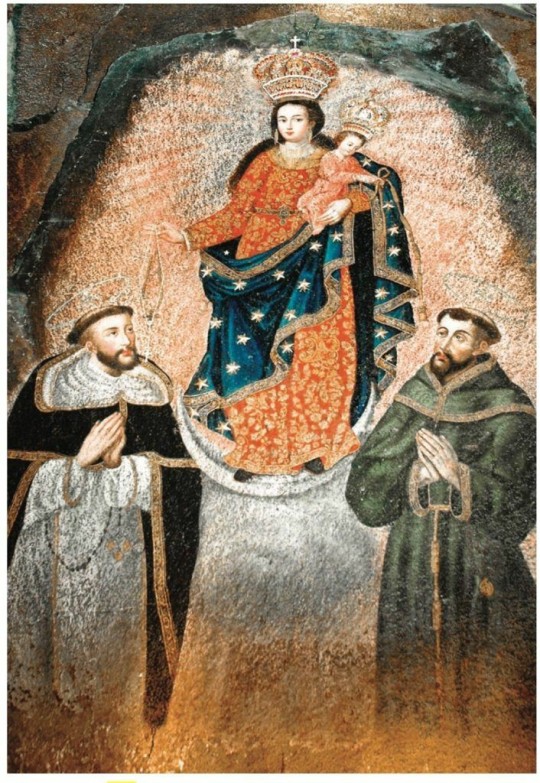
This image was imprinted on the rocks of a gorge above the Guaitara River in Colombia near the border of Ecuador. It has the singular characteristic of having been made by Angels. The image is situated inside a cave very high in the mountains, and was completely unknown until it was discovered in the mid-18th century by an Indian. It was not painted, but mysteriously imprinted in the rock. The colors are not applied in a surface layer of paint or other material, but penetrate deep into the rock. No one knows how the work was done. Certainly it has no natural geological cause. These circumstances seem to indicate that it is an akeropita image – akeropita in Greek means not made by human hands, id est, made by the Angels.
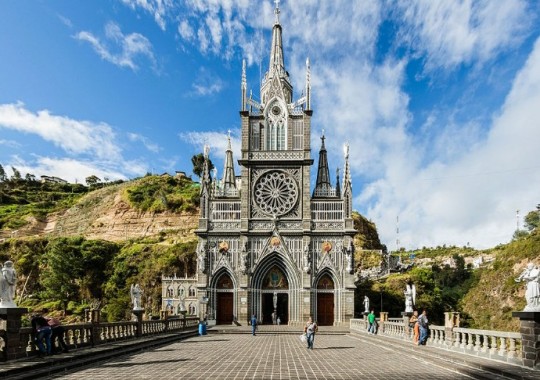
Front entrance to the shrine.
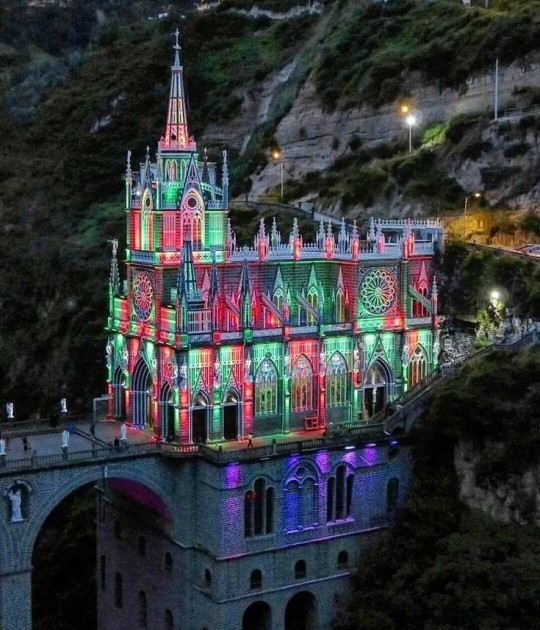
Illumination of the church.
#Las Lajas Sanctuary#Our Lady of Las Lajas#Colombia#basilica church#Roman Catholic Churches#Ipiales#Gothic Revival#miracles#apparition#Virgin Mary#pilgrimage sites#culture and arts#20th century churches#architecture#Jesus#churches and cathedrals#religious architecture#Gothic Revival architecture#buildings#architectural elements#architectural design
13 notes
·
View notes
Photo

Una de las cascadas que caen desde el cañón del río Guaitara. #Ipiales, #Nariño, #Colombia. (en Ipiales, Narino) https://www.instagram.com/p/B6zLM36j1CA/?igshid=wf5danj4uq6q
1 note
·
View note
Text

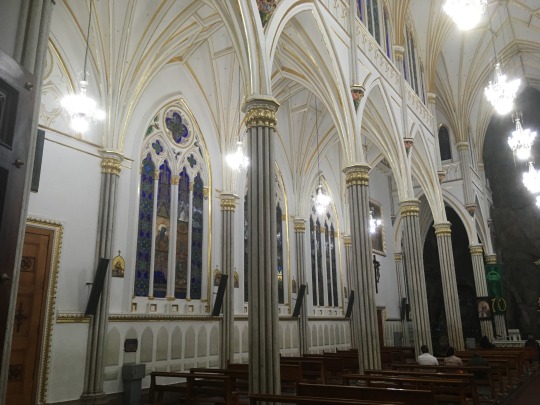
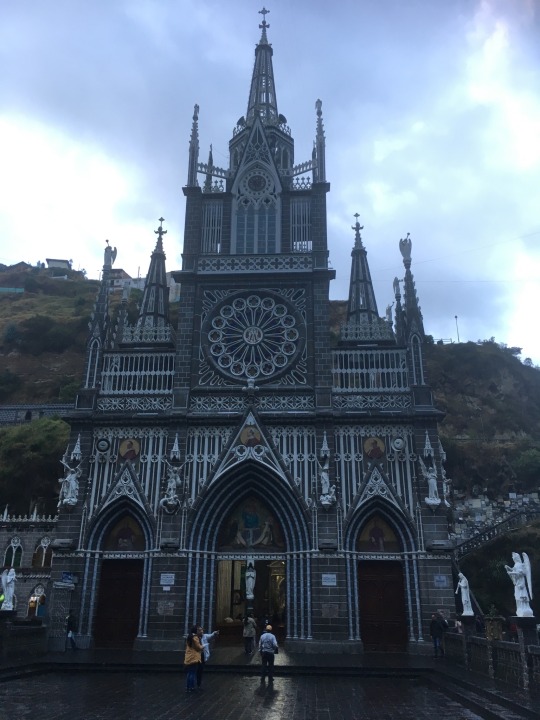

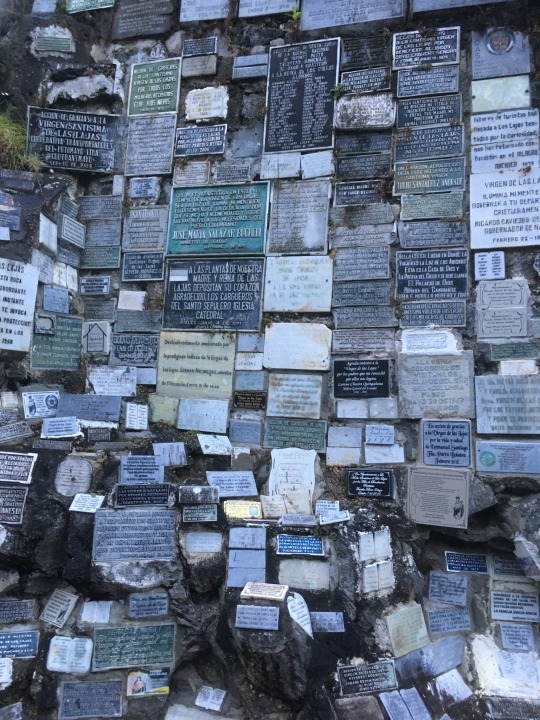

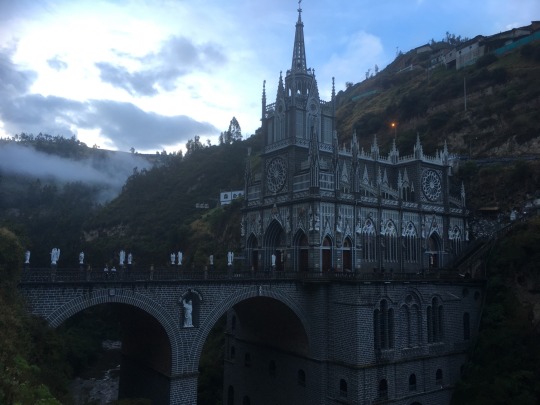
I was really lucky to spot this Gem of a hotel (Hotel Casa de Peregrinos) which is right beside the famous Las Lajas cathedral in Ipiales. The cathedral was built in the 20th century in a deep gorge of the Guaitara river. I arrived at 5.30 after 11.30 hours of driving and still had time to have a look around before it went dark. For Diner I found a restaurant and took the meal of the day veg soup followed by Roasted chicken and rice £2 wow.
2 notes
·
View notes
Text
Chiêm ngưỡng 12 nhà thờ đẹp nhất thế giới
Chiêm ngưỡng 12 nhà thờ đẹp nhất thế giới
Không chỉ là nơi diễn ra các hoạt động tôn giáo mà những nhà thờ này còn thu hút khách tham quan bởi thiết kế độc đáo.
1. Nhà thờ Las Lajas Sanctuary, Colombia
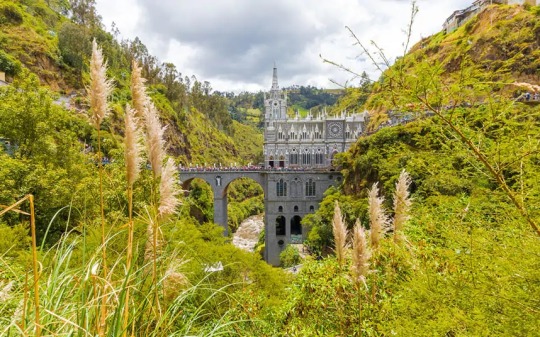
Đây là một Đại thánh đường nằm tại miền nam Nariño (Colombia), thuộc thành phố tự trị Ipiales và được xây dựng ở độ cao 100m bên trong hẻm núi sông Guaitara.
Las Lajas, được xây dựng theo lối kiến trúc Gothic từ năm 1916 đến năm 1949 và…
View On WordPress
0 notes
Photo

Our Universal Mother - Part 45
Our Lady of Las Lajas - Columbia - Feast Day September 16
Our Lady of Las Lajas (not painted—mysteriously imprinted in the rock) this image of Our Lady appears to be made not by human hands, but made by the Angels.
Our Lady of Las Lajas
by Prof. Plinio Corrêa de Oliveira
In Spanish las lajas means "the rocks." This image was imprinted on the rocks of a gorge above the Guaitara River in Columbia near the border of Ecuador. It has the singular characteristic of having been made by angels. The image is situated inside a cave very high in the mountains, and was completely unknown until it was discovered in the mid-18th century by an Indian.
It is not painted, but mysteriously imprinted in the rock. The colors are not applied in a surface layer of paint of other material, but penetrate deep into the rock. No one knows how the work was done. Certainly it has no natural geological cause. I have never heard of any case where nature reproduced human faces with such perfection.
The image represents a noble Lady from an uncertain period, most probably 16th or 17th century Spain. How such a picture came to be in that cave unnoticed by anyone remains a mystery. These circumstances seem to indicate that it is an akeropita image - akeropita - in Greek means not made by human hands, id est, made by the Angels.
How can the beauty of this image be described? I will comment on two aspects: the colors and the persons.
The ensemble of colors in the picture gives an undeniable idea of majesty. The colors behind Our Lady’s head create a splendorous background. The burgundy of her dress is a warm, rich red embroidered with a golden flower pattern, giving the impression of the garment of a Queen. Her long hair flows freely in such a way that it appears to be a royal mantle. In my opinion, there is extraordinary good taste in the way the hair is arranged, which reinforces the notion of majesty.
The two crowns are very beautiful, rich and royal, but I think they are a little too large for the proportion of the heads. They were added by the faithful later in thanksgiving for graces received.
Now, we can look at Our Lady’s face and observe how she watches us from on high with a serious probing gaze. She is not smiling. She has the royal physiognomy of a person who imposes respect with confident strength. In contrast, the Divine Infant is very amiable and is turned toward the supplicant. Thus, instead of having the classic picture of a serious Child and a smiling Mother, here we have the opposite. One could say that He is distributing the gifts while she appears as a Queen.
In reality, there is something profound in this contrast. It is the idea that He is merciful because He is seated in Our Lady’s arm. He communicates to the person who prays a little of His happiness to be with her.
Is there something strange about the Child? It seems to me that He is very small in size. His face and attitude are those of an older boy, notwithstanding the small size. Is this a mistake or is it meant to express something? It appears that it expresses His wisdom at each stage of His life. He did not have the weaknesses of lack of reason of a normal child. His wisdom was perfect at every age of His life. So, what the image expresses is that even when He was very small, He was already conscious of everything He did, as an older boy would be.
After having considered the Child, if we return our eyes to Our Lady we can see how the image expresses motherhood. She is not looking at Him directly, but she has an enormous intimacy with Him. She extends this maternity to the sinner who kneels before her. She is also his Mother. This image is a masterpiece reflecting both the majesty and the maternity of Our Lady.
History
A bit of history taken from the Colombian website ipitimes.com (Click Below)
http://www.ipitimes.com/llscac.htm
Historians and scientists are at a loss to explain this fabulous image on the wall of a South American cave. It may forever remain an enigma.
Back in the 18th century, Maria Mueses de Quinones, an Indian woman from the village of Potosi, Colombia, often walked the six miles between her village and the neighboring one of Ipiales. One day in 1754 as she was making the journey, she approached the place called Las Lajas (the Rocks), where the trail passes through a deep gorge of the Guaitara River. Maria never liked this part of the trail. There were rumors that a cave in Las Lajas was haunted. Such superstitions lingered amongst the converted Christian Indians.
She was carrying her daughter Rosa, a deaf-mute, on her back in the Indian fashion. By the time she had climbed to Las Lajas, she was weary and sat on a rock to rest. The child got down from her back to play.
After a while, Rosa emerged from the cave shouting: "Mama, there is a woman in here with a boy in her arms!" Maria was beside herself with fright since this was the first time she had heard her daughter speak. She did not see the figures the girl was talking about, nor did she want to. She grabbed the child and hastened on to Ipiales.
When she recounted what had happened, no one took her seriously at first. However, as the news spread, some asked if perhaps it were true. After all, the child was now able to speak.
A few days later, the child Rosa disappeared from her home. After looking everywhere, the anguished Maria guessed that her daughter must have gone to the cave. The child had often said that the Lady was calling her. Maria ran to Las Lajas and found her daughter in front of a noble Lady and playing affectionately with a Child who had come down from His mother’s arms to let the girl enjoy His divine tenderness. Maria fell to her knees before this beautiful spectacle; she had seen the Blessed Virgin and the Divine Infant. Fearful of ridicule, Maria kept quiet about the episode. But she and Rosa frequently went to the cave to place wild flowers and candles in the cracks of the rocks.
Months went by, with Maria and Rosa keeping their secret. Finally, one day the girl fell gravely ill and died. A distraught Maria decided to take her daughter’s body to Las Lajas to ask the Lady to restore Rosa to life.
Moved by the sadness of Maria’s unrelenting supplications, the Blessed Virgin obtained Rosa’s resurrection from her Divine Son. Overflowing with joy, Maria returned home. It was not long before a crowd had gathered to hear what had happened. Early the next morning everyone went to Las Lajas, each one wanting to check the details for themselves.
That was when the marvelous picture of Our Lady on the wall of the grotto was discovered. Maria Muese de Quinones could not recall noticing it until then. The Child Jesus is in Our Lady’s arms. On one side of Our Lady is St. Francis; on the other is St. Dominic. Her delicate and regal features are those of a Latin American, perhaps an Indian. Her abundant black hair covers her like a mantle (The two-dimensional crown is metal and was added by devotees much later on). The Indians had no doubt: this was their Queen.
5 notes
·
View notes
Link
via Últimos anuncios añadidos - Clasificados Pasto | Paginas Amarillas Pasto| Directorio Comercial Pasto | MARZO 2019
#IFTTT#Últimos anuncios añadidos - Clasificados Pasto | Paginas Amarillas Pasto| Directorio Comercia
0 notes
Text
20 Incríveis construções situadas em lugares inacreditáveis
Existem construções no mundo muito famosas por sua arquitetura e formas incomuns, ganhando fama e atraindo turistas curiosos. As construções abaixo, por exemplo, ganharam fama não só pela beleza, mas pelos locais incomuns onde estão situadas, como em lugares muito altos e até sobre uma cachoeira.
1 – Monastério de Simonopetra
O Mosteiro Simonopetra é um mosteiro ortodoxo oriental situado na Grécia. Fica num penhasco, a 330 metros acima do nível do mar. Ele foi construído no século XIV por São Pedro.
2 – Mosteiro de Panagia Hozoviotissa
O Mosteiro de Panagia Hozoviotissa está encrustado num penhasco na Grécia, e parece fazer parte do próprio penhasco, formando uma paisagem fascinante. O local foi construído em 1017 por ordem do Imperador Aleixo I Comneno e fica a 300 metros do nível do mar.
3 – Mosteiros de Metéora
Também conhecidos como mosteiros suspensos no céu, estão localizados na Grécia e surgiram da ideia dos monges ermitões do século XI, que se instalaram em cavernas próximas ao topo da formação rochosa com o objetivo de ficar mais próximos do céu e de Deus.
4 – Capela de Saint-Michel d’Aiguilhe
Esta capela está localizada na França, e para chegar até ela é preciso subir mais de 200 degraus. Dizem que foi construída para celebrar os peregrinos que fazem o Caminho de Santiago, rota feita por muitas pessoas em busca de ajuda espiritual.
5 – Templo suspenso
O mosteiro suspenso ou Mosteiro Xuankong, também conhecido como templo suspenso, é um mosteiro construído perto do monte Heng, na Província de Shanxi, China. Ele foi construído por um único homem, há mais de 1500 anos.
6 – Mosteiro de São Jorge de Coziba
O Mosteiro de São Jorge de Coziba é habitado por monges ortodoxos gregos. O local é bem afastado da cidade, e o acesso só é possível por uma ponte onde só há espaço para pedestres.
7 – Casa Kaufmann
A Casa Kaufmann, nos EUA, fica em cima de uma cachoeira, e foi construída no ano de 1939. O local possui fama mundial pela beleza da construção e da localização. Morar nesta casa permite um contato maior com a natureza e seria o sonho de muitas pessoas.
8 – Castelo Ninho da Andorinha
Quando olhamos esse castelo, temos a impressão que ele vai cair do penhasco a qualquer momento. Ele foi construído no ano do 1895 em Gaspra, numa região disputada por Rússia e Ucrânia. O castelo já sobreviveu ao abandono e a um terremoto, e hoje funciona como um restaurante aberto ao público.
9 – Castelo Predjama
O Castelo Predjama está situado na Eslovênia. De acordo com histórias populares, foi construído por Erasmo, um cavaleiro que estava em busca de proteção por sofrer perseguição do rei Frederico III, que tinha ordenado sua morte. Os homens enviados para matar Erasmo ficavam à espera dele nos arredores do castelo, achando que poderiam capturá-lo quando ele saísse em busca de mantimentos. Porém, Erasmo saía escondido pelo outro lado da montanha, já que havia uma conexão com a caverna. Por muitos anos ele conseguiu escapar desta forma.
10 – Parque Nacional Mesa Verde
O Parque Nacional Mesa Verde, nos EUA É considerado Patrimônio Mundial pela UNESCO, e está localizado condado de Montezuma, Colorado. Foi construído por aborígenes anasazi no século VI, e a localização (debaixo de um penhasco) foi escolhida por garantir uma maior proteção de eventuais ataques inimigos, neve e catástrofes naturais.
11 – Templo Dourado de Dambulla
O Templo Dourado de Dambulla, no Sri Lanka é um conjunto muito antigo de cavernas com templos em seu interior. Data dos séculos II e III a. C., foi escavado diretamente nas rochas das cavernas por ordem do rei Valagamba de Anuradhapura.
12 – Santuário de Las Lajas
O Santuário de Nuestra Señora de Las Lajas é um lugar de culto e turismo na Colômbia desde o século XVIII. O Santuário esta localizado no cânion do rio Guaitara e forma uma linda paisagem que atrai muitos turistas.
13 – Gate Tower Building
O prédio foi construído no meio de uma rodovia e fica no Japão. O design peculiar é resultado da insistência dos donos do terreno, que, apesar das constantes negativas dos responsáveis pelo projeto arquitetônico (já que a rodovia tinha sido planejada antes), conseguiram transformar o projeto em realidade, por mais estranho que pareça.
14 – Casa em Roque-Gageac
Essa é uma das casas localizadas em Roque-Gageac comuna francesa que também já era habitada na pré-história. Os moradores faziam suas casas perto das cavernas e das rochas para se protegerem contra ataques de inimigos e catástrofes naturais. As casas continuaram sendo ocupadas, e hoje o local é tido como um dos mais bonitos da França
15 – Jal Mahal
Só é possível chegar ao Jal Mahal de barco. Há quem conte que o prédio foi construído no século XVIII por Maharaja Madho Singh, que teria exigido esse tipo de arquitetura para facilitar a caça de patos. Outra tese diz que o palácio era uma “simples” residência de verão.
16 – Casa Flutuante
Casas flutuantes são muito comuns no Reino Unido, Canadá e na Austrália. Na Suécia, inclusive, existem hotéis flutuantes. Deve ser uma experiência incrível passar alguns dias em uma casa assim.
17 – Pavilhão de Shibaozhai
O local foi construído durante o reinado de Xianfeng, na colina Shibaozhai, na China. Tem 200 metros de altura e nove andares. No topo funciona um templo budista. O principal motivo que levou à construção do pavilhão foi ajudar os visitantes a chegar ao topo da Shibaozhai, já que antes era preciso percorrer um longo trajeto passando por várias cavernas.
18 – Dar al-Hajar
Dar al-Hajar é um palácio construído sobre uma rocha e fica no Iêmen. O local foi construído no ano de 1876 a. C., como um retiro de verão. É um dos edifícios mais chamativos do Iêmen.
19 – Casa à beira de penhasco
Pessoas que têm medo de altura com certeza não passariam um dia por lá. Esta casa foi construída na Austrália sobre o oceano, e é o lugar perfeito para os amantes da natureza, que não tenham medo de altura, é claro.
Fonte: Incrivel Club
O post 20 Incríveis construções situadas em lugares inacreditáveis apareceu primeiro em Tudo Interessante.
Leia aqui a matéria original
O post 20 Incríveis construções situadas em lugares inacreditáveis apareceu primeiro em Tesão News.
source https://tesaonews.com.br/noticia-tesao/20-incriveis-construcoes-situadas-em-lugares-inacreditaveis/
0 notes
Text
Colombia Best Places Top 10
Cano Cristales
Whether it’s known as Caño Cristales, the Liquid Rainbow or the River of Five Colors, this really can be one natural milestone that should really be on every traveler’s excursion. Unfortunately Caño Cristales, was closed to tourism as 1989 as a result of FARC presence within the neighboring areas but some tourist agencies have lately began offering carefully crafted tours into the location. The river is situated outside the small town of La Macarena in the federal park called Serranía de la Macarena. Plants, stones, sand and algae give color to the lake, that may seem black, white, green, white, yellow or bright red based on location. Hiking along the banks of the Caño Cristales can be an adventure on its own, but travelers may also head to the waterfall of Los Cuarzos or float in the pools formed by the lake itself.
Santuario de Las Lajas
Only north of the border with Ecuador is your Santuario de Las Lajas, one of the most fascinating religious structures in each Colombia. Constructed responsibly onto a bridge that crosses the Guaitara River, the Santuario de Las Lajas resembles it’s straight out of a fairy tale. The Gothic style cathedral was built from early 20th century thanks to a financial donation from sailors, and there’s currently a small museum located within the construction. Dealing with the Santuario de Las Lajas is easy from the local town of Ipiales, where travelers may join guided tours into the palace.
Salt Cathedral of Zipaquira
Only one hour drive north of Bogota is currently Zipaquirá, a city known as the salt mining capital of Columbia. As a result of salt mining,” Zipaquirá has had a concentration of extreme riches. One of the things that high lights that really may be the Salt Cathedral of all Zipaquirá, which will be a Catholic church assembled nearly entirely of salt in an now defunct mine. Although this is a significant tourism destination, even the Salt Cathedral actually accommodates almost 3,000 parishioners every Sunday, and attending a church service is definitely an unforgettable experience. Surrounding the palace is a region called the Salt Park, where visitors can observe other landmarks over the mines and also find out about the industry at the Brine Museum.
Valle de Cocora
The symbol of Colombia may be the wax hands, and also the Valle de Cocora is your ultimate spot to see such trees in a magnificent atmosphere. The surreal scene is really a lush green, and the fog lifts it is possible to see that the tremendous elevation of the wax palms growing vertical across the slopes of the valley. The picture itself is the main attraction at Valle de Cocora, however there are multiple ways to view all of it. Popular options include horseback riding, Jeep tours and also a six-hour walking loop.
Carnaval de Barranquilla
While a lot of people today associate Carnaval with Rio de Janeiro in Brazil, the Colombian city of Barranquilla is obviously home to the world’s next largest Carnaval. During Carnaval de Barranquilla, the city is overrun with festivals, live music and street parades. The celebrations kick off with La Batalla de Flores, or the Battle of the Flowers, at which parade floats are decorated with flowers in brilliant and magnificent designs. Attendees usually wear bright colours or costumes that reflect a figure or perhaps even a fable in Colombian heritage.
La Guajira
The enormous Caribbean slopes in the very northerly tip of Colombia are still home for a number of the nation’s most spectacular shores, enchanting scenery, and also the ideal kitesurfing from the nation. Additionally there is the incredibly off the beaten track Macuira National Park to detect also. 2018 is certainly the season to detect the special marvels of this Guajira.
The Choco Pacific Coast
The wild jungles of Colombia’s Pacific Coast region are some of the most biodiverse on Earth, and therefore are among the most useful destinations in Colombia for nature lovers. Between June and October it is possible to watch humpback whales, in September sea turtles arrive to lay their own eggs, and in the event that you are not as a nature freak then you always have the option to go surfing instead.
Los Nevados National Park
The Los Nevados National Park is glancing at a high altitude and is based around a number of this country’s most incredible freshwater peaks. The snow-covered Nevado Del Ruiz and Nevado del Tolima, amongst the others, serve as the park’s most important attraction. Hiking is a popular pastime, and those with a series of adventure can camp at the park’s back country. There is also the opportunity to identify the local wildlife, which includes spectacled bears, tiger cats, Andean condors and pumas.
Monserrate
The city of Bogota can be a exceptional capital due to its high altitude, some thing which becomes conspicuous with a trip to Monserrate. On peak of the mountain of Monserrate, that overlooks the town, there’s really a 17th century church that functions as a mecca for religious pilgrims. Certainly one of the greatest ways to have Bogota is by simply driving the funicular train or perhaps even the aerial tramway to the top of Monserrate. From that point, it’s likely to observe the sun setting within Downtown Bogota at a truly dramatic fashion.
Cartagena’s Old Town
Arguably one of the very popular attractions in Colombia is the historical Old Town of Cartagena. This city has been the 1st of those Spanish settlements in Colombia, and also the Old Town is exploding with historic colonial architecture. The walled Old Town, that is also referred to as the Ciudad Amurallada, comprises several elderly neighborhoods and landmarks. Of specific note is the Plaza Trinidad in the Getsemaní area, which is the oldest portion of the Hawaiian town and also a heart for local eateries. Benefit from the coastal location and also try fried fish with a side of arroz de coco, or coconut rice.
Colombia Best Places Top 10
0 notes
Text
Những kiệt tác kiến trúc ‘có một không hai’ ai thấy cũng phải trầm trồ ngưỡng mộ
Cùng chiêm ngưỡng những kiệt tác kiến trúc theo phong cách hiện đại ấn tượng và đẹp nhất thế giới hiện tại.
1. Nhà thờ Las Lajas Sanctuary ở Nariño – Colombia
Las Lajas Sanctuary tọa lạc tại phía nam tỉnh Narino, Colombia, bên trong hẻm núi sông Guaitara. Nhà thờ được xây trong vòng 33 năm, từ 1916 đến 1949, cao 100 mét tính từ đáy hẻm núi, với một cây cầu cao 50 mét bắc ngang nối hai bờ. Nhà thờ mang phong cách tân Gothic này đứng trên 130 chân cầu cao được xây dựng trên sông Guaitara. Hai cộng đồng tôn giáo Phanxicô từ Colombia và Ecuador chăm sóc mục vụ của thánh đường, do đó đây là công trình tượng trưng cho hòa bình và đoàn kết giữa nhân dân hai nước Nam Mỹ.
2. Nhà hoa sen – Trung Quốc
Trụ sở chính của nha kế hoạch thị trấn Thường Châu, Giang Tô, Trung Quốc là một sự kết hợp của 3 kết cấu nằm sát nhau với tạo hình của những bông hoa sen đang chớm nở trong đầm nước. Đặc biệt, nhờ vào thiết kế và cách sắp đặt mà công trình này có thể gây được ấn tượng cho mọi người kể cả khi nhìn trực diện lẫn từ trên xuống.
3. Tòa nhà Cubic – Hà Lan
Quần thể công trình có hình dáng kì lạ trong ảnh chính là tập hợp của 40 ngôi nhà dân sinh tại đường Overblaak, Rotterdam, Hà Lan.
Kiến trúc sư Piet Blom, cha đẻ của công trình đặc biệt này, đã thiết kế nó dựa trên hình tượng của rừng cây xanh, mà ở đây thân cây chính là tầng 1 của ngôi nhà, còn tán cây lại được cách điệu hóa thành tầng 2 với kết cấu hình rubik hết sức độc đáo. Ngoài ra, tuy có thiết kế lạ thường nhưng không gian bên trong hoàn toàn cân đối và tiện nghi như bao ngôi nhà ở khác.
4. Nhà thờ trong suốt tại Limburg – Bỉ
Nhà thờ này được xây dựng vào năm 2011 với chiều cao 10m và được làm bằng 100 lớp cắt và 2000 cột thép. Nhà thờ có thể được coi là một công trình bằng gỗ hoặc kim loại khổng lồ, và dường như nó hòa tan trong cảnh quan. Hình dáng của nhà thờ phụ thuộc vào góc nhìn của khách tham quan. Họ nói rằng, từ xa, nhà thờ trông như đang bay lên khỏi mặt đất.
5. Trung tâm triển lãm Heydar Aliyev – Azerbaijan
Heydar Aliyev là một công trình nổi danh ở Azerbaijan cũng như trên toàn thế giới của nữ kiến trúc sư Zaha Hadid. Vốn là một người yêu thích xu hướng thiết kế độc, dị theo kiểu “ngoài hành tinh”, Zaha Hadid đã quyết định lấy hình tượng dòng chất lỏng mềm mại, uốn lượn để làm nền móng cho thiết kế của trung tâm triển lãm kiêm tổ hợp văn phòng này và thực sự cô đã tạo nên một công trình có dáng dấp của tương lai.
6. Đền Vàng Harmandir Sahib tại Amritsar của Ấn Độ
Nhắc đến thành phố Amritsar của Ấn Độ thì không thể không nhắc đến ngôi đền dát 100 tấn vàng nổi tiếng Harmandir Sahib – nơi mệnh danh là thánh địa linh thiêng của đạo Sikh.
Đến đền Vàng Harmandir Sahib bạn sẽ không khỏi ấn tượng vì sự xa hoa, lộng lẫy cũng như kiến trúc độc đáo của nó. Ngôi đền này được xây dựng vào năm 1574 và khác những ngôi đền khác chỉ có 2 lối vào như thông thường thì đền Vàng lại mở rộng đến 4 lối ra vào đón chào mọi du khách. Đặc biệt khi ghé qua ngôi đền linh thiêng nhất của đạo Sikh vào ban đêm thì bạn sẽ khó lòng mà không choáng ngợp bởi ánh sáng lung linh của những ánh đèn được thắp lên khắp nơi.
7. Cao ốc Capital Gate – UAE
Có chiều cao 158,5 mét gồm 35 tầng, tòa nhà Capital Gate, tọa lạc tại Abu Dhabi, UAE là một trong những cao ốc có thiết kế “dị” nhất trên thế giới. Thậm chí, tòa tháp này còn được tổ chức kỉ lục thế giới công nhận là công trình có độ nghiêng lớn nhất ở thời điểm hiện tại (góc nghiêng trên Capital Gate đạt 18 độ trong khi đó tháp nghiêng Pisa nổi tiếng của Italia chỉ là 4 độ).
8. Bảo tàng Guggenheim – Tây Ban Nha
Bảo tàng Guggenheim được đánh giá là một trong những công trình kiến trúc ấn tượng nhất trong thời đại của chúng ta. Điểm đặc biệt của bảo tàng này chính là thiết kế theo phong cách Deconstructivism (tạm dịch là: kiến trúc giải tỏa kết cấu). Theo đó, kiến trúc sư sẽ sử dụng trí tưởng tượng ở mức cao nhất của mình để kiến tạo hình hài của công trình thật bất cân đối, lộn xộn phá vỡ những quy chuẩn vốn có trong kiến trúc.
9. Nhà thờ Hồi giáo Blue ở Istanbul
Nhà thờ Hồi giáo Blue ở Istanbul (Thổ Nhĩ kì) được xây dựng vào đầu những năm 1600, khi đế chế Ottoman đang ở thời kì đỉnh cao. Là một trong những nét nổi bật nhất trên đường chân trời Istanbul, nhà thờ Hồi giáo Sultan Ahmed gây sửng sốt cả về quy mô và phạm vi.
Nội thất của nhà thờ vô cùng lộng lẫy, với hơn 20.000 viên gạch men màu xanh và hơn 50 mẫu thiết kế hoa tulip khác nhau đã đem đến biệt danh cho nhà thờ Hồi giáo này.
10. Phòng triển lãm Friendly Alien – Áo
Công trình kì lạ trong hình chính là phòng trưng bày các tác phẩm nghệ thuật hiện đại mang tên “Friendly Alien” (tạm dịch: người ngoài hành tinh thân thiện”). Được biết, hình dáng của tòa nhà được lấy cảm hứng từ loài trùng biến hình với nhiều sự cách điệu để nó vừa trở nên độc đáo vừa phù hợp hơn với một phòng triển lãm.
Thêm vào đó, vào ban đêm, Friendly Alien sẽ phát ra ánh sáng kì ảo khiến bất kì ai nhìn từ xa cũng lầm tưởng nó là một sinh vật ngoài hành tinh khổng lồ thực sự.
Theo Leona/Thethaovanhoa
Nguồn: Những kiệt tác kiến trúc ‘có một không hai’ ai thấy cũng phải trầm trồ ngưỡng mộ
from Ms Vui https://msvui.com/80505
via IFTTT
0 notes
Text
Những kiệt tác kiến trúc ‘có một không hai’ ai thấy cũng phải trầm trồ ngưỡng mộ
Cùng chiêm ngưỡng những kiệt tác kiến trúc theo phong cách hiện đại ấn tượng và đẹp nhất thế giới hiện tại.
1. Nhà thờ Las Lajas Sanctuary ở Nariño – Colombia
Las Lajas Sanctuary tọa lạc tại phía nam tỉnh Narino, Colombia, bên trong hẻm núi sông Guaitara. Nhà thờ được xây trong vòng 33 năm, từ 1916 đến 1949, cao 100 mét tính từ đáy hẻm núi, với một cây cầu cao 50 mét bắc ngang nối hai bờ. Nhà thờ mang phong cách tân Gothic này đứng trên 130 chân cầu cao được xây dựng trên sông Guaitara. Hai cộng đồng tôn giáo Phanxicô từ Colombia và Ecuador chăm sóc mục vụ của thánh đường, do đó đây là công trình tượng trưng cho hòa bình và đoàn kết giữa nhân dân hai nước Nam Mỹ.
2. Nhà hoa sen – Trung Quốc
Trụ sở chính của nha kế hoạch thị trấn Thường Châu, Giang Tô, Trung Quốc là một sự kết hợp của 3 kết cấu nằm sát nhau với tạo hình của những bông hoa sen đang chớm nở trong đầm nước. Đặc biệt, nhờ vào thiết kế và cách sắp đặt mà công trình này có thể gây được ấn tượng cho mọi người kể cả khi nhìn trực diện lẫn từ trên xuống.
3. Tòa nhà Cubic – Hà Lan
Quần thể công trình có hình dáng kì lạ trong ảnh chính là tập hợp của 40 ngôi nhà dân sinh tại đường Overblaak, Rotterdam, Hà Lan.
Kiến trúc sư Piet Blom, cha đẻ của công trình đặc biệt này, đã thiết kế nó dựa trên hình tượng của rừng cây xanh, mà ở đây thân cây chính là tầng 1 của ngôi nhà, còn tán cây lại được cách điệu hóa thành tầng 2 với kết cấu hình rubik hết sức độc đáo. Ngoài ra, tuy có thiết kế lạ thường nhưng không gian bên trong hoàn toàn cân đối và tiện nghi như bao ngôi nhà ở khác.
4. Nhà thờ trong suốt tại Limburg – Bỉ
Nhà thờ này được xây dựng vào năm 2011 với chiều cao 10m và được làm bằng 100 lớp cắt và 2000 cột thép. Nhà thờ có thể được coi là một công trình bằng gỗ hoặc kim loại khổng lồ, và dường như nó hòa tan trong cảnh quan. Hình dáng của nhà thờ phụ thuộc vào góc nhìn của khách tham quan. Họ nói rằng, từ xa, nhà thờ trông như đang bay lên khỏi mặt đất.
5. Trung tâm triển lãm Heydar Aliyev – Azerbaijan
Heydar Aliyev là một công trình nổi danh ở Azerbaijan cũng như trên toàn thế giới của nữ kiến trúc sư Zaha Hadid. Vốn là một người yêu thích xu hướng thiết kế độc, dị theo kiểu “ngoài hành tinh”, Zaha Hadid đã quyết định lấy hình tượng dòng chất lỏng mềm mại, uốn lượn để làm nền móng cho thiết kế của trung tâm triển lãm kiêm tổ hợp văn phòng này và thực sự cô đã tạo nên một công trình có dáng dấp của tương lai.
6. Đền Vàng Harmandir Sahib tại Amritsar của Ấn Độ
Nhắc đến thành phố Amritsar của Ấn Độ thì không thể không nhắc đến ngôi đền dát 100 tấn vàng nổi tiếng Harmandir Sahib – nơi mệnh danh là thánh địa linh thiêng của đạo Sikh.
Đến đền Vàng Harmandir Sahib bạn sẽ không khỏi ấn tượng vì sự xa hoa, lộng lẫy cũng như kiến trúc độc đáo của nó. Ngôi đền này được xây dựng vào năm 1574 và khác những ngôi đền khác chỉ có 2 lối vào như thông thường thì đền Vàng lại mở rộng đến 4 lối ra vào đón chào mọi du khách. Đặc biệt khi ghé qua ngôi đền linh thiêng nhất của đạo Sikh vào ban đêm thì bạn sẽ khó lòng mà không choáng ngợp bởi ánh sáng lung linh của những ánh đèn được thắp lên khắp nơi.
7. Cao ốc Capital Gate – UAE
Có chiều cao 158,5 mét gồm 35 tầng, tòa nhà Capital Gate, tọa lạc tại Abu Dhabi, UAE là một trong những cao ốc có thiết kế “dị” nhất trên thế giới. Thậm chí, tòa tháp này còn được tổ chức kỉ lục thế giới công nhận là công trình có độ nghiêng lớn nhất ở thời điểm hiện tại (góc nghiêng trên Capital Gate đạt 18 độ trong khi đó tháp nghiêng Pisa nổi tiếng của Italia chỉ là 4 độ).
8. Bảo tàng Guggenheim – Tây Ban Nha
Bảo tàng Guggenheim được đánh giá là một trong những công trình kiến trúc ấn tượng nhất trong thời đại của chúng ta. Điểm đặc biệt của bảo tàng này chính là thiết kế theo phong cách Deconstructivism (tạm dịch là: kiến trúc giải tỏa kết cấu). Theo đó, kiến trúc sư sẽ sử dụng trí tưởng tượng ở mức cao nhất của mình để kiến tạo hình hài của công trình thật bất cân đối, lộn xộn phá vỡ những quy chuẩn vốn có trong kiến trúc.
9. Nhà thờ Hồi giáo Blue ở Istanbul
Nhà thờ Hồi giáo Blue ở Istanbul (Thổ Nhĩ kì) được xây dựng vào đầu những năm 1600, khi đế chế Ottoman đang ở thời kì đỉnh cao. Là một trong những nét nổi bật nhất trên đường chân trời Istanbul, nhà thờ Hồi giáo Sultan Ahmed gây sửng sốt cả về quy mô và phạm vi.
Nội thất của nhà thờ vô cùng lộng lẫy, với hơn 20.000 viên gạch men màu xanh và hơn 50 mẫu thiết kế hoa tulip khác nhau đã đem đến biệt danh cho nhà thờ Hồi giáo này.
10. Phòng triển lãm Friendly Alien – Áo
Công trình kì lạ trong hình chính là phòng trưng bày các tác phẩm nghệ thuật hiện đại mang tên “Friendly Alien” (tạm dịch: người ngoài hành tinh thân thiện”). Được biết, hình dáng của tòa nhà được lấy cảm hứng từ loài trùng biến hình với nhiều sự cách điệu để nó vừa trở nên độc đáo vừa phù hợp hơn với một phòng triển lãm.
Thêm vào đó, vào ban đêm, Friendly Alien sẽ phát ra ánh sáng kì ảo khiến bất kì ai nhìn từ xa cũng lầm tưởng nó là một sinh vật ngoài hành tinh khổng lồ thực sự.
Theo Leona/Thethaovanhoa
Nguồn: Những kiệt tác kiến trúc ‘có một không hai’ ai thấy cũng phải trầm trồ ngưỡng mộ
from Ms Vui https://msvui.com/80505
via IFTTT
0 notes
Photo
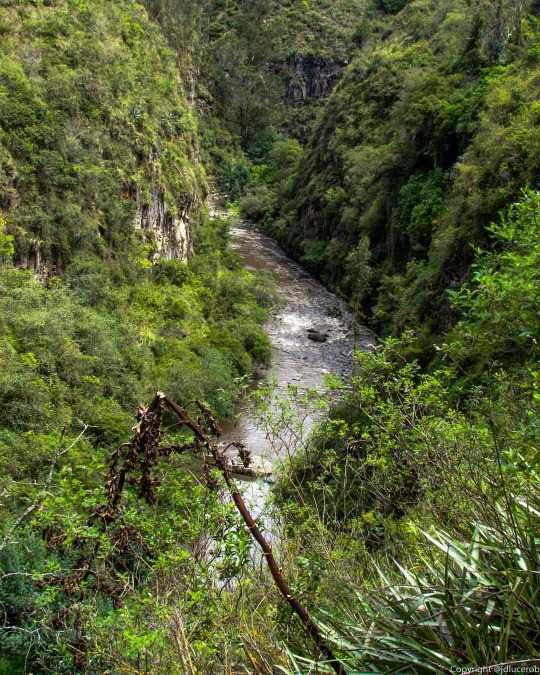
Cañón del río Guaitara. También conocido como Pastaran en el pueblo indígena de los Pastos. #Potosi, #Nariño, #Colombia. https://www.instagram.com/p/B7MEK8Sp2WR/?igshid=1jv2wjbjzrftj
0 notes
Text
EL SANTUARIO DE LAS LAJAS y SU VIRGEN, EN IPIALES. Por Artur Coral
Con la más reciente información sobre la Virgen y el templo más bello del mundo (Actualización continua)
IPIALES, NARIÑO, COLOMBIA
ENLACES CON ACTIVIDAD CONTINUA: El Santuario de Las Lajas en Twitter
_______________________________________________
FIESTAS DE LA VIRGEN DE LAS LAJAS 2017, EN IPIALES

LA "FIESTA DE LA VIRGEN DE LAS LAJAS" 2017, EN IPIALES
FIESTAS PATRONALES - 15 de septiembre: Aparición milagrosa; 16 de septiembre: Celebración
La Fiesta se celebra en honor a Nuestra Señora del Rosario de Las Lajas "la Virgen Mestiza" como la llama la tradición, "la Virgen de Roca o Laja", en el decreto de coronación canónica (Esta fue la primera publicación subida a la Internet en Colombia, por Artur Coral, desde Nueva York, el 31 de octubre de 1993, cuando IPITIMES.COM se llamaba "Ipiales Internet Magazine": El Magazine exclusivo de Ipiales, en la Internet).
ENLACES /LINKS
LAS LAJAS / THE SHRINE OF OUR LADY OF LAJAS DE COLOMBIA NARIÑO IPIALES
youtube
HISTORIA DE LA VIRGEN DE LAS LAJAS (Duración: 25 Min)
youtube
. [INFO.] LA VIRGEN DE LAS LAJAS (Wikipedia)
. [Français] SANCTUAIRE DE LAS LAJAS : LA BASILIQUE AU-DESSUS DU CANYON (Trésors du monde)
. [Français] Notre-Dame de Las Lajas .. Depuis le XVIIIe siècle, le Sanctuaire de Las Lajas est un lieu de culte et un pèlerinage situé dans le canyon formé par la rivière Guaitara, à 7 km de la ville d'Ipiales .. (La Carte Mariale du monde)
. [Français] Histoire et Origine de Notre-Dame de Las Lajas (La Carte Mariale du monde)
. [Français] Les 7 merveilles de la Colombie (Que chevere)
. [English] About the Miraculous Image of Our Lady of Las Lajas (My Consecration)
________________________________________________
youtube
↑ El Santuario de Las Lajas (Video por Juan Camilo - 17 Abr 2017)
EL SANTUARIO DE NUESTRA SEÑORA DE LAS LAJAS, EN IPIALES, LA IGLESIA MAS BELLA DEL MUNDO
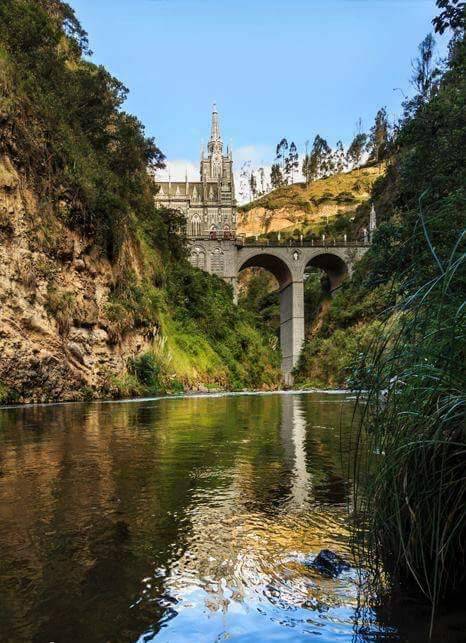
↑ El Santuario de Las Lajas en Ipiales. (Crédito: Ipiales Humor)
. Cinco destinos turísticos de Nariño (Radio Nacional de Colombia - 13 Abr 2017)
. Piden a caminantes no realizar romería a Las Lajas .. La advertencia de las autoridades se dio luego de los deslizamientos presentados en días pasados. -- (El Tiempo - 12 Abr 2017)
. Fomentan turismo del Santuario de Las Lajas (HSB Noticias - 22 Mar 2017)
. Recibieron a nuevo párroco del santuario de Las Lajas (HSB Noticias - 27 Feb 2017)
. Santuario de Las Lajas, una maravilla de Colombia al borde de un abismo .. Al borde de un abismo en la cordillera de los Andes, a 2.900 metros sobre el nivel del mar, se levanta imponente el Santuario de Las Lajas, una basílica de estilo neogótico considerada maravilla turística de Colombia. .. (Efetur - 24 Ene 2017)
. Una maravilla colombiana al borde de un abismo (El Observador de Uruguay - 21 Ene 2017)
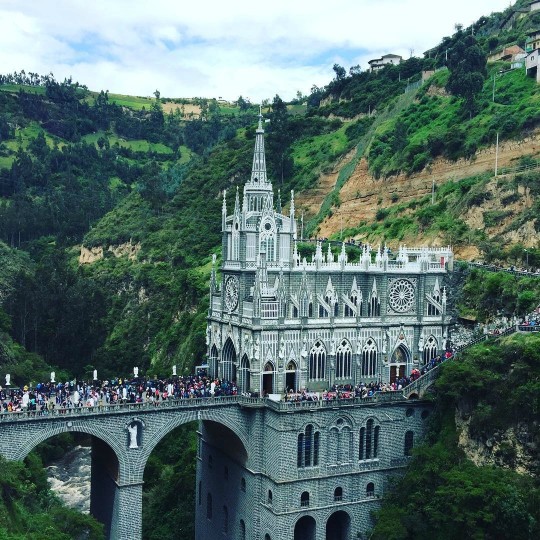
↑ El Santuario de Las Lajas en Ipiales. (Crédito: Pueblos Patrimonio)
. Nombraron a nuevo párroco de Las Lajas, en Ipiales (HSB Noticias - 18 Ene 2017)
. TURISMO RELIGIOSO Nuestra Señora de Las Lajas Por su ubicación y arquitectura, el santuario de Las Lajas, en Colombia, está considerado uno de los más bellos del mundo. (Listin Diario - 18 Ene 2017)
. Destinos colombianos para el 2017 .. El Santuario de Las Lajas en Ipiales, Nariño es considerado como una de las iglesias más bellas del mundo .. (El Tiempo - 15 Ene 2017)
. El santuario de las lajas, uno de los más visitados de América Latina (El Nuevo Diario - 15 Ene 2017)

↑ El Santuario de Las Lajas, una maravilla al borde de un abismo (El Heraldo - 14 Ene 2017) (Foto por Artur Coral)
. Las Lajas, atractivo que internacionalizó a Nariño (HSB Noticias - 25 Dic 2016)
. Un espectáculo de luces en el Santuario de Las Lajas (Noticias RCN - 17 Dic 2016)
0 notes
Text
17 photos of sacred sites that will awaken the traveler in you
By Antonia Blumberg
Perched on mountaintops and nestled into busy cities are some of the world’s most dazzling sacred sites. If you’re looking for a spiritual pilgrimage, then look no further than these remarkable houses of worship around the globe.
From the red rocks of Arizona to the bustling streets of Moscow, these sacred sites are sure to inspire some wanderlust:
Wat Rong Khun: Chiang Rai, Thailand
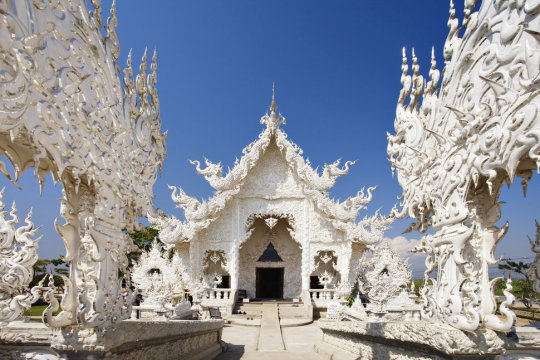
William Manning via Getty Images
Thailand’s Wat Rong Khun, or White Temple, attracts thousands of tourists every year with its intricate carvings depicting surprisingly modern figures and themes, including aliens, Superman, and scenes from “The Matrix.”
Church of the Transfiguration: Kizhi Island, Russia

jejim via Getty Images
Built in the early 18th century, Russia’s Church of the Transfiguration features an octagonal spruce and pine log framework with 22 domes covered with birch bark. Construction of the wooden structure began in 1714, and it is said to have been built without a single nail.
Popa Taungkalat Monastery: Mount Popa, Myanmar

Photo by Supoj Buranaprapapong via Getty Images
Popa Taungkalat Monastery is situated in the shadow of the nearby Mount Popa, a famous pilgrimage site in Myanmar. Visitors can climb 777 steps to this secluded Buddhist monastery to explore numerous shrines and see breathtaking views of the surrounding mountains.
Chapel of the Holy Cross: Sedona, Arizona

Photo Researchers via Getty Images
The Chapel of the Holy Cross springs out of Sedona’s famous red rock and is considered one of Arizona’s seven man-made wonders.
Sanctuary of Truth: Pattaya, Thailand

YURY_TARANIK via Getty Images
Thailand’s Sanctuary of Truth is an all-wood building filled with sculptures based on traditional Buddhist and Hindu motifs. It is covered in intricate wood carvings, meant to depict complex ideas about ancient thought, human responsibility, and the cycle of life.
The Great Synagogue of Florence: Tuscany, Italy
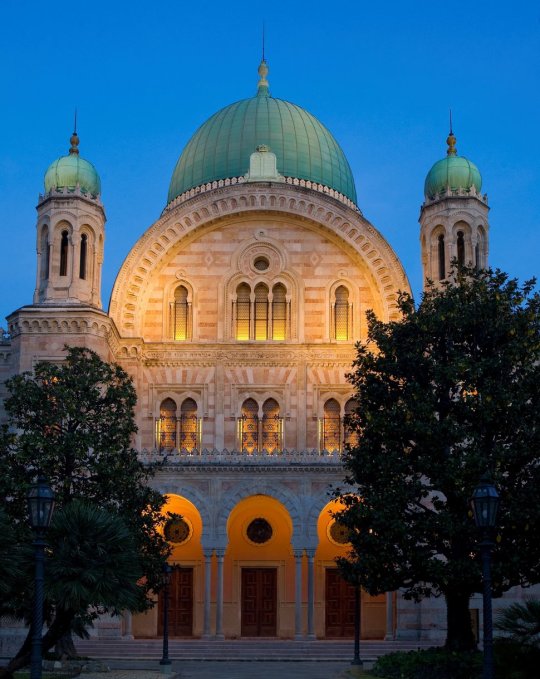
Marka via Getty Images
The Tempio Maggiore, or Great Synagogue, of Florence took eight years to build and opened its doors in 1882 near the historic center of the Italian city. It was intended to serve the local Sephardi community, and its design echoes motifs from the Moorish architecture of Spain.
Roussanou Monastery: Thessaly, Meteora, Greece
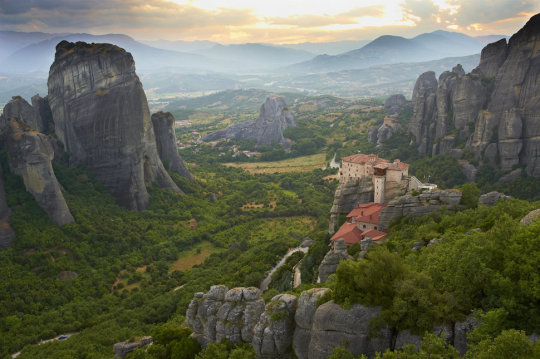
Tuul & Bruno Morandi via Getty Images
The Roussanou Monastery is one of six precarious religious sites that rise out of Greece’s rock cliffs. The cliffs were first inhabited in the 9th century by hermit monks. Centuries later, the secluded rock pillars provided monks with protection from political upheaval. Although the Meteora rock formation once held 20 monasteries, only six survive today
Basilique Du Sacré-Coeur: Paris, France
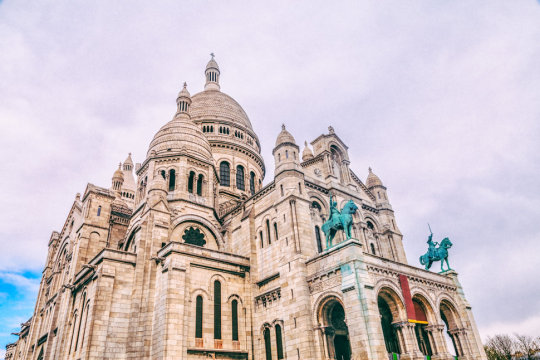
serts via Getty Images
The Sacré-Cœur sits atop the hill of Montmartre, Paris’s artistic district. Not only is it one of the most important European basilicas, but it provides a breathtaking panoramic view of Paris’ skyline. Visitors can climb 270 steps to the top of the Sacré-Cœur for an unforgettable experience.
Malacca Straits Mosque: Malaysia
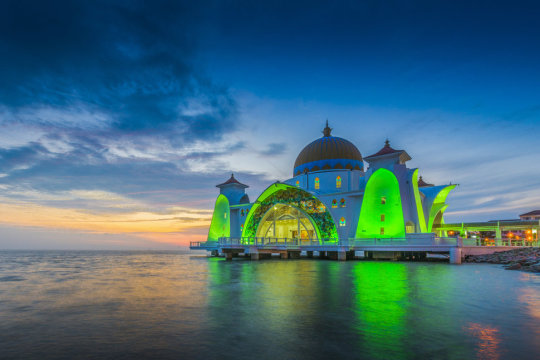
Tanatat pongphibool ,thailand via Getty Images
The Malacca Straits Mosque is located on a man-made island in Malaysia. This gorgeous mosque is also called the “Floating Mosque“ for an illusion it gives off of sitting right on top of the water.
Cathedral of Brasilia: Brasilia, Brazil
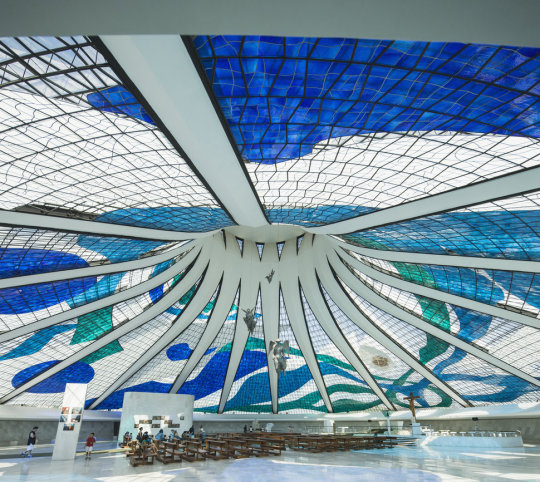
Atlantide Photo travel via Getty Images
This metropolitan cathedral is truly a masterpiece. The innovative hyperboloid structure was designed by architect Oscar Niemeyer and is full of intricate details, from the suspended angels to the sweeping columns.
Angkor Wat: Siem Reap, Cambodia
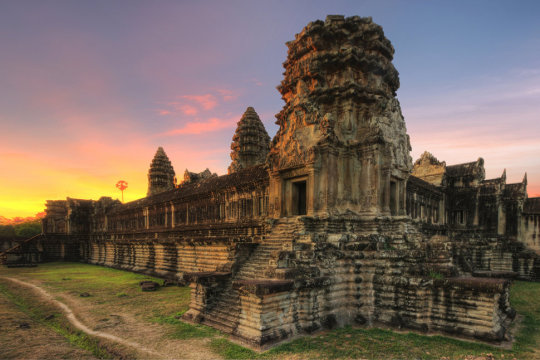
Artie Photography (Artie Ng) via Getty Images
Angkor Wat is the largest religious site in the world, expanding across 162.6 hectares of land. What is now the Angkor Archaeological Park once served as the center of the Khmer Empire, a dominating force in Southeast Asia from the 9th to the 15th century. The inhabited park is intimately connected to nature, and part of its land remains a forest.
The Temple of Heaven: Beijing, China
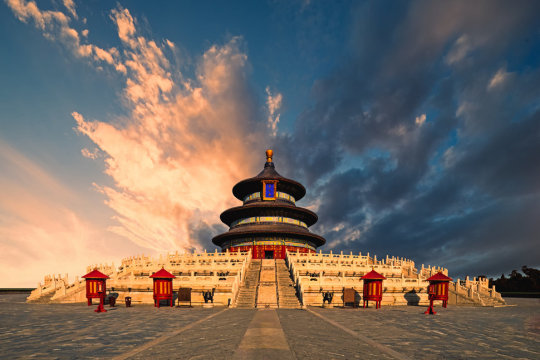
shunli zhao via Getty Images
This intricate temple complex dates back to the 15th century, and in 1998 it was named a UNESCO World Heritage Site. The Hall of Prayer for Good Harvests is the three-tiered centerpiece to a number of complex structures, each built according to rigid philosophical guidelines.
Sheikh Zayed Mosque: Abu Dhabi, UAE
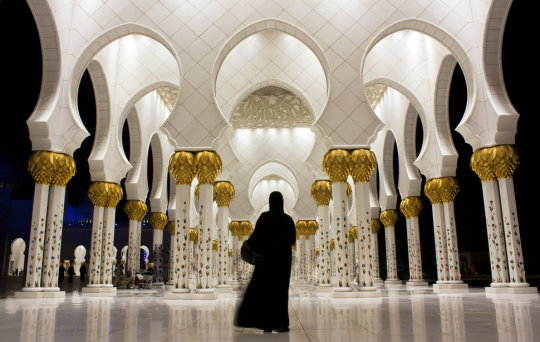
© Naufal MQ via Getty Images
With its sleek white architecture and tranquil reflecting pool, Abu Dhabi’s grand mosque stuns day and night. It is the largest and most important mosque in the United Arab Emirates, drawing over 41,000 people for Eid prayers.
Sagrada Familia: Barcelona, Spain
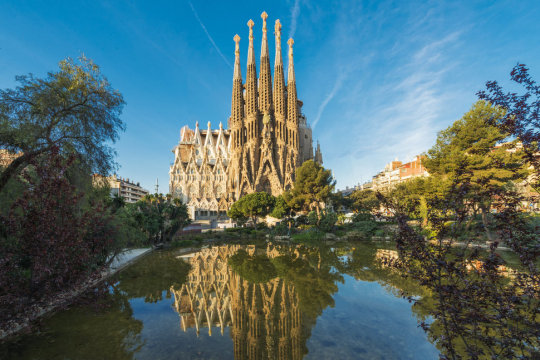
Tanatat pongphibool ,thailand via Getty Images
This whimsical cathedral is renowned as Antoni Gaudí’s principal architectural masterpiece. The design is so intricate that the cathedral was not finished in Gaudí’s lifetime; it has been under construction since 1882 and is scheduled to be finished in 2026, marking the centennial of Gaudí’s death. Don’t miss the incredible stained glass interior.
Basilica de Notre Dame, Montreal, Quebec, Canada

Wei Fang via Getty Images
Located in the heart of Old Montreal, the Notre-Dame basilica is not only an important place of worship, but also a key Canadian landmark. Instead of depicting scenes from the Bible, the Basilica’s stained glass features scenes from Montreal’s religious history.
Las Lajas Church: Colombia
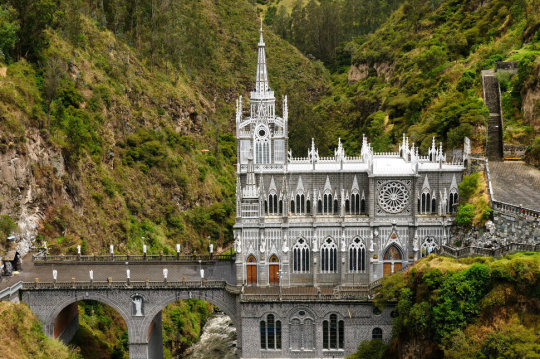
rchphoto via Getty Images
Located near the border of Colombia and Ecuador, the Las Lajas Sanctuary is undoubtedly one of the most beautiful basilicas in the world. The precarious gothic revival structure is built into the canyon of the Guaitara River, connecting the two banks. The church was constructed in honor of two legendary miracles, and its miraculous location surely pays tribute to these origins.
St. Basil’s Cathedral: Moscow, Russia
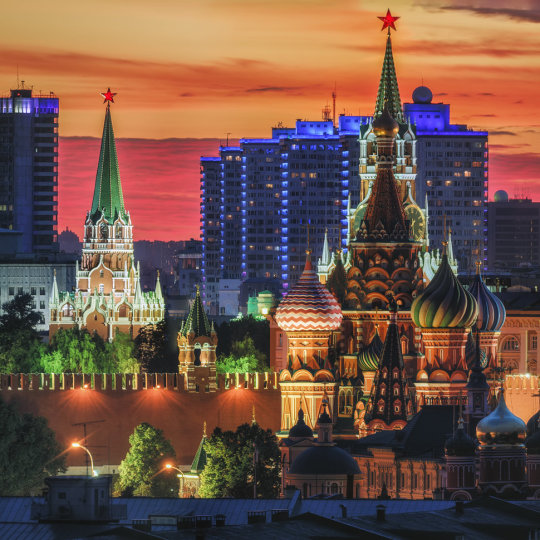
2013 © Sergey Alimov via Getty Images
Saint Basil’s Cathedral is the focal point of Moscow’s Red Square, its bright colors bound to capture any visitor’s eye. This UNESCO World Heritage site’s unique architecture resembles a bonfire, with its multi-layered towers rising up towards the sky like flames.

Huffington Post
1 note
·
View note
Photo

Guaitara River, Colombia
(by a.pic.a.day)
#guaitara river#guaitara#river#colombia#south america#travel#photography#church#architecture#vertical
167 notes
·
View notes
Link
via Últimos anuncios añadidos - Clasificados Pasto | Paginas Amarillas Pasto| Directorio Comercial Pasto | MARZO 2019
#IFTTT#Últimos anuncios añadidos - Clasificados Pasto | Paginas Amarillas Pasto| Directorio Comercia
0 notes